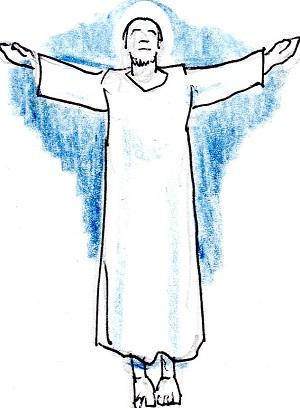
"In my distress I called upon the Lord, and he heard my voice" (Psalm 18).
Jeremiah the prophet describes the web of intrigue tightening around him as his enemies plot a way to destroy him (Jer 20:10-13).
Jesus hands his fate over by openly blaspheming -- claiming to be one with God (John 10:31-42). The climactic dialogue between Jesus and his critics moves the fourth Gospel to its central theme: Jesus is the divine messenger sent to save the world. He will be “lifted up,” meaning both crucified and glorified, as the ultimate revelation of God’s unconditional love for a sinful world.
Anyone who sees (believes) in Jesus will be drawn to him, incorporated into the mystery of his divine life. Everything on this worldly side of the drama converges on the cross. Everything in glory will emanate from the resurrection into an utterly transformed future.
Do we believe this? Can our eyes peer back through two millennia and hundreds of generations of people who have asked the same question, through the complex tangle of human efforts to understand, explain, debate, accept or deny the fragments of evidence and the lived experience that affirm the truth of these events? Each year we dare stand at the door between time and eternity to probe this question during Holy Week. Do I believe that the life, death and resurrection of Jesus defines the path forward for human meaning?
Faith holds us on the hinge of that door we believe swings open briefly on Good Friday and Easter Sunday. In the week before Palm Sunday, we recall the death of Archbishop Oscar Romero in 1980. He died at the altar with the promise on his lips of the seed that falls to the ground in order to multiply, his own blood consecrating the Liturgy of sacrifice. We pray for Pope Francis, whose time with us is always fragile and whose mission to open the church to the world is being resisted. He will lead our Palm Sunday procession, perhaps from a hospital bed as his breath becomes more precious. Who will announce God’s Spring in a world gripped by another Winter of anger and fear?
What is the work of faith? Each year I think back to the end of Franco Zeffirelli’s dramatic 1977 film, Jesus of Nazareth, when Mary of Magdala confronts the apostles huddled in fear and doubt. She has seen the risen Jesus, and she looks to them to believe her. Peter, after a night of utter failure and shame, says, “We all failed him… I denied him because I was a coward. But we all deserted him.” This is the foundation of our faith, that despite our failure, he does not fail us, but reveals the community of forgiveness that has continued to tell of God’s mercy for a sinful world.
Everything depends on how we interpret the silence that falls upon the world following Jesus’ death, waiting for our reply. This is where earthly evidence ceases and faith begins. Here is the decisive gap where we are invited to leap across, trusting that the bridge will appear. Jesus is that bridge between human and divine, natural life destined to know eternal life with him in the community of God.
We do this every day we say yes to God and show we understand Jesus by dying to ourselves in order to live for others. Eternity begins here for anyone who gives himself or herself away in self-surrendering love. Next stop, Palm-Passion Sunday.





